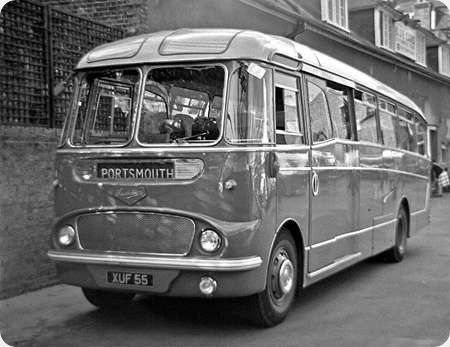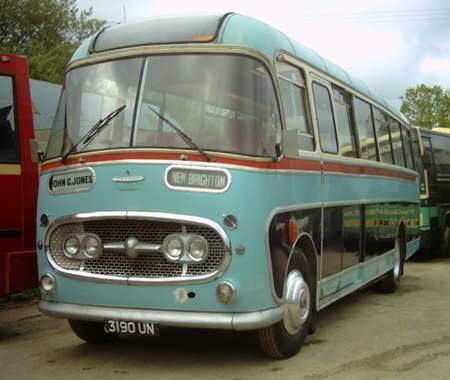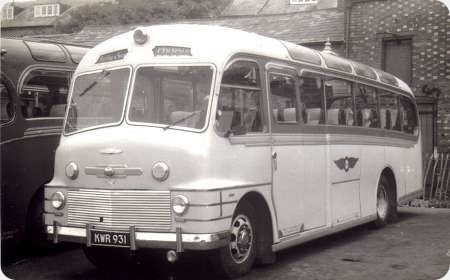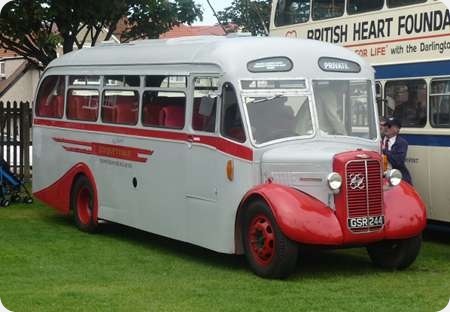
Southdown Motor Services Ltd
1960
Commer Avenger IV
Harrington C35F
Southdown, ever primarily a Leyland operator (though Guy got a look in from time to time) also had a modest requirement for lighter chassis. Despite having operated the OB model successfully, Southdown then eschewed the Bedford SB when it looked for a lightweight coach chassis in the late 1950s. It is understandable that the Bedford petrol engine did not appeal, and the alternative Perkins R6 was not a very attractive diesel option either. From 1960 Bedford offered the SB with a Leyland engine, but even this did not entice the Southdown company. Instead, whilst still favouring Leyland’s lightweight Tiger Cub, hitherto highly conservative Southdown became surprisingly interested in the unconventional Tilling Stevens TS3 opposed piston, three cylinder, horizontal two stroke engine, and bought 25 Beadle Rochester C41F coaches in 1956-57. In 1959, after further Tiger Cub deliveries, Southdown returned to the TS3 engine with a batch of 15 Commer Avengers with Burlingham C35F bodies, their first from this coachbuilder since the 1930s. Another batch of 15 Avengers followed in 1959-60, but these were given Harrington Crusader Mk1 C35F bodies. The Beadles and the Commers all gave up to 12 years service with Southdown, the last being sold off in 1971. I recall seeing – and hearing – the Avengers quite regularly on the Brighton service along the A23. Their distinctive sound was unmistakeable. Seen here tucked away in a corner of Victoria Coach Station in 1960 is the last of the Harrington batch, No.55, XUF 55.
Photograph and Copy contributed by Roger Cox
10/03/16 – 15:45
I hope the panelling and upholstery had sound deadening qualities of the highest order. Detroit diesels of the period had a reputation for noise but the TS3 was in a league of its own!
Phil Blinkhorn
11/03/16 – 05:56
A further batch followed 41-55 shown in Roger’s picture. There were 15, numbered 56-70 (56-70 AUF) and were also bodied by Harrington. I assume that they were identical to the earlier batch, but my memory of seeing them can no longer recall any detailed differences, if any. I have just looked through the 2-volume history of Southdown by Colin Morris (Venture 1994), and the Vol.2 fleet list only prints the Beadle-Commers 1-25, and has neither list or photo of the Commer Avengers 26-70! Perhaps he had been deafened by the first 25?
Michael Hampton
11/03/16 – 05:56
It may be the angle of the photograph but this vehicle has a rather narrow look about it. Were these coaches 7ft 6ins. or 8ft. wide?
Chris Barker
11/03/16 – 05:57
I’m not sure, Phil. I’ve been in a TS3-engined bus only twice: once in recent years in a preserved coach at King Alfred Running Day at Winchester, and once fifty years ago driving some folk from Reading to Portchester, Hants, in a coach belonging to Spiers of Henley-on-Thames. As to the noise emanating from the exhaust pipe I agree with you all the way, but inside the vehicles things seemed reasonably quiet. Perhaps I enjoyed the sound so much that I was making undue allowances for it…
Commers raise a question in my mind: are they really a lightweight in the same sense as a Bedford or a Ford is?
We often call the Leyland Tiger Cub a lightweight, but I’d prefer a term like "three-quarterweight" or "quality lightweight", since the feel of a Tiger Cub is solid and precise, like that of a heavyweight. In the same way a Guy LUF is every bit as solid as the over-heavy UF.
On that basis perhaps the Commer is a "five-eighths-weight".
Interested to hear fellow OBP-ers’ views.
Ian Thompson
11/03/16 – 12:05
I don’t recall seeing any of these at all – were they based in Portsmouth?
I’ve found a photo of one of each batch side-by-side and they look identical. SEE //tinyurl.com/z49qe6x
Chris Hebbron
11/03/16 – 15:26
That’s a fine image of the two examples from each batch standing together. The only difference I can see is that the XUF driver’s mirrors are attached at the top of the windscreen, whereas the AUF mirrors are attached at the bottom. (And of course the windscreen wipers are facing in opposite directions…). My 1970 fleet list (SEC) shows the Portsmouth allocation as 6 XUF + 3 AUF [9], Eastbourne 4 XUF + 3 AUF [7], Worthing 7 AUF, and Brighton 5 XUF + 2 AUF [7], so they were quite well spread along the coast. The earlier Burlingham bodied batch (26-40) were at Eastbourne (3), Brighton (6), and Chichester (6). This is likely to have been their final allocations as Roger Cox notes that they had all gone by 1971, and the list I’m quoting from is accurate to 1st November 1970.
Michael Hampton
12/03/16 – 05:47
There is one more minor difference between them and that is that the XUF’s sported only a nearside spotlight; the AUF’s, one each side. Thanks, for the allocation details, Michael. You’d have thought that Southdown would have kept them all at one depot for ease of maintenance. Whilst I was looking for a photo of the other batch, I noticed photos of some of these vehicles working for contractors, showing that some had a further life beyond Southdown.
Chris Hebbron
12/03/16 – 05:48
I think all of Southdown Commer coaches and all of the Commer-powered Beadle coaches were eight foot wide. The reason that the Harrington-bodies look narrow is that they are tall compared to similar bodies on Thames or Bedford chassis.
Stephen Allcroft
Roger Cox
Thanks, Michael for reminding me that there was a further batch of the Harringtons. The straight framed Avenger was introduced in 1949, and the overall dimensions of the 109 bhp 4.75 litre six cylinder petrol engined Mk I were 27ft 6ins by 7ft 6ins. In 1952 the Mk II increased the available dimensions to 30 ft by 8ft, but the petrol engine was retained. Then, in 1954, the Mk III appeared offering the TS3 engine as an option, and this became the Mk IV from 1956 when the petrol and smaller chassis alternatives were dropped. The standard rear axle ratio was 4.3 to 1, but the Eaton two speed axle was also offered. Taking up Ian’s point about internal noise, the compact horizontal engine was installed over the front axle where the (no doubt well insulated) floor went over it, and this contributed to the apparent height of the vehicle. The engine was thus some way forward of the main saloon. Externally, of course, it was a different matter, and one could hear TS3 powered coaches and lorries approaching when they were still leagues distant. The TS3 engine developed 105 bhp at 2400 rpm, but as with other large two strokes, the torque curve was very peaky. Torque rose from 245 lb ft at 800 rpm to a maximum of 270 lb ft at 1200 rpm, but then fell away sharply to 225 lb ft at the 2400 rpm governed speed. Theoretically, the 3.26 litre two stroke TS3 equated to a four stroke motor of about 6.5 litres, though some efficiency and power losses inherent in the type, notably the requirement for a Roots blower to aid induction and scavenging of the cylinders, does prejudice a direct comparison. Nevertheless, as an illustration, the Gardner 5LW of 6.974 litres yielded 300 lbs ft of torque across the entire working speed range. At 1700 rpm the TS3 delivered only some 87 bhp against the 94 bhp of the Gardner. Even so, fuel consumption figures of up to 20 mpg were claimed for the TS3. The standard gearbox in the Avenger Mk IV was a four speed synchromesh unit, for which an optional overdrive was available, but a close ratio five speed constant mesh box was also offered. I am not sure which of these the Southdown coaches had, though I suspect the synchromesh. According to my records, the bare chassis weight of the Avenger was 3.125 tons, the maximum permissible gross weight being 9 tons. The maximum gross weight figure for the contemporary Bedford SB was 8.26 tons. The unladen weight of a bodied contemporary Tiger Cub was about 6 tons, which, with the full added weight for passengers, fuel, luggage etc, would raise this to a maximum of around 9 tons. Perhaps, as Ian suggests, the Avenger was in a similar weight category to the Tiger Cub rather than that of the lighter Bedford.
Roger Cox
13/03/16 – 14:54
Thx for the extra information, Roger. 20mpg was very good fuel consumption and quite possible the prime reason, along with reliability, why this engine was so popular, when two strokes were not highly regarded generally. I don’t know how general is the knowledge that Rootes were well into developing a four-cylinder version of the engine, with several prototypes on the bench. However, this was stymied by the Chrysler takeover and a clash with a similar effort between Chrysler and Cummins. This resulted in a TSR2 scenario, with orders to scrap all traces of this engine’s existence. Suffice to say that the Cummins engine was a complete failure and with the Plan B TS4 scrapped, that was it. There are some stupid people about! The full story can be found here: //tinyurl.com/gvjjutt
Chris Hebbron
14/03/16 – 06:52
I can confirm that my TS3 Rochester regularly achieves 18/20 mpg unless on a hilly route.
My father was development driver for the TS4 and I believe there is a thread somewhere on here about that engine
Roger Burdett
19/03/16 – 17:34
Roger Burdett’s actual consumption of 18-20 mpg for his TS3 Rochester is very impressive. The power saved by having no valvegear to drive must be more than balanced by the energy needed to drive the Roots blower, and all those extra large moving parts look as though they ought to sap power, but evidently not. Since simple crankcase-scavenge 2-stroke engines—whether petrol or diesel—always show poor fuel consumption, it’s easy to assume that all 2-strokes are thirsty by nature, yet the most economical prime mover ever built was the Wärtsilä-Sulzer RT-flex 96C 2-stroke marine engine, which is well worth Googling, until it was recently just overtaken by a 4-stroke engine (model 31) by the same Finnish builder. Both these engines are admittedly a trifle bulky for a coach, but they show what’s possible.
Roger, how does the consumption of your rear-engined Foden coach compare with that of other vehicles of a similar weight?
Ian Thompson
21/03/16 – 09:00
Ian my Foden consumption is around 12mpg but is inherently more unreliable than the Commer. The fuel system is more complex with a hydraulic governor and to be honest has not had the use it deserved. My LS Gardner powered which is comparable weight is c13.5mpg. The Leylands do around 12 and the Midland Reds 10.
As a rule all my Gardners do 13-14mpg whether 5LW; 6LW, or 6HLX except for my Tilling Stevens which with an overdrive 6LW does 17/18. The Commer is 3.1 litre with no overdrive but is incredibly fuel efficient as you say with the direct injection and a fairly low vehicle weight. The Roots blower once it is moving has far fewer parts than a a vehicle with valve gear. I do run the vehicle between 55-65mph on the motorway which always surprises speed limited modern coaches!
Roger Burdett
14/09/16 – 14:05

Here is a picture of my TS3 Avenger IV The Commer stands at 11 foot high so does look narrow but it is in fact the height that creates the illusion.
Yes 20 mpg is returnable without difficulty, as is cruising at 60 mph.
Russell Price
15/09/16 – 06:46
Those consumption figures for the TS3 engine underline the utter folly of Chrysler in abandoning the promising TS4 development. That engine would have surely been a winner, giving up to 200 bhp and 465 lb ft torque at 1800 rpm, all from 4.7 litres. The TS3 also proved to be outstandingly reliable, the weakest part apparently being the drive to the Roots blower. In playing the American card and going for V6/V8 from Cummins, Chrysler bought possibly the worst engine lemons ever to go into volume production. It’s a miracle that Cummins survived that debacle. On that note, there is a picture on the following site of a Black & White Daimler Roadliner fitted with a TS3 engine:- www.flickr.com/photos/
I gather that it performed quite satisfactorily, and I wonder why others didn’t try this conversion. Today large two stroke engines fall foul of emission regulations, but the TS4 could have had its heyday well before those rules came into force.
Roger Cox
16/09/16 – 06:24
My father was test driver at Rootes for the TS4 and noise would have killed it as the harmonics were much greater than the Cummins. Let us not forget Cummins was part of Chrysler at that time and the V6/V8 production was only a small part of a big world wide conglomerate.
My father drove the V8 everyday in lorry form and units used to go Coventry-Linwood return 6 days per week up days back nights (different driver). That was 3500 miles per week. Reliability was an issue but never as great as in the Buses or the AEC V8 in the lorries
Roger Burdett
16/09/16 – 06:24
I believe it was noise regulations of 1972/3 that finally killed off the TS3 and TS4. I would agree in 30 odd years of owning it is a well engineered reliable machine.
Russell Price
16/09/16 – 13:35
I was working for Chrysler in Truck development at the time of the TS4. As we understood it, the TS4 greatly outperformed the Cummins V6/V8 in all aspects, but Cummins (a major part of Chrysler at the time) had invested a lot of cash in the V6/V8 and they did not intend to lose it! All the tooling for the TS4 had been ordered & delivered to the Whitley plant in Coventry, where it was put into store and eventually sold for scrap…brand new & unused. It was said at the time that caused the collapse and subsequent closure of Herbert Machine Tools. Cummins "Red Engines" had a number of unusual design feature. They were high speed diesels, which was a problem since drivers were not used to revving a diesel to get performance. In fact a special rev counter was fitted to the trucks with a green band (gear shifting range) and a blue band, complete with a sticker that read "Always drive in the blue band". All fuel lines were drilled into the block, so it was a "clean" engine on the outside, but a problem if you got a blocked fuel line. Originally fitted with rocker operated 3 hole injectors, they suffered a bit of fuel starvation. This was overcome by changing to 5 hole injectors, which were slightly taller than the 3 hole and so necessitated changing the push rods, otherwise, bent push rods and a very unhappy engine! How do we know this? Let’s just say put it down to personal experience and move on!! The V8 was 185hp and the V6 was 160 hp. I think the only production Dodge that had the V6 was the L600, low height chassis, whereas Guy Motors took the V6 for a full size truck (Guy Warrior I think). The failure rate on the Red Engines was huge and we had a large pile of dead engines in the Whitley compound (Chrysler truck development relocated to Coventry from Luton & Dunstable at the end of the 1960’s). I hope this is of interest to you.
David Field
16/09/16 – 17:09
Thanks to David Field for the latest comments. The engine Guy used in the Big J was the VIM v-6 & Vine v-8. These were going to be built in the UK at the former Henry Meadows factory in a joint venture with Jaguar which did not go through. To bring things back to buses it was the Cummins VIM v-6 of 9.6 litres and 192bhp that was launched in the Daimler Roadliner.
Stephen Allcroft
17/09/16 – 05:11
A further bit of trivia regarding the TS3. Lord Rootes was a man who was not renowned for great judgement or making the best decisions. For example, after WW2 he was offered a choice of German engineering businesses as reparation for the damage done to Rootes group factories in UK. His options were VW car manufacturing or a rather strange and obscure 2 stroke engine being developed for aeroplanes (Heinkel I think). He chose the latter, apparently on the basis that the VW would never prove to be popular!
Does anyone know if TS3 engine PSV’s used the Maxiload oil bath air cleaner (located under the passenger seat on the truck) and the Cooper’s self cleaning muffler? Why I ask is because when the TS3 was stretched to 135hp in it’s final form (a stretch too far) one of the problems was that the blower shaft would snap. The first sign of this was a drop in power and the second sign was black oily smoke pouring out through the air filter – not good in a PSV. The quick way of replacing the shaft was to remove the radiator to get to the front of the engine. The front part of the broken shaft was easy to get at, but the rear part involved careful use of a couple of welding rods fused together and poked down the hole. The idea was that you would strike an arc onto the steel shaft and not the alloy block! I was wondering how you get to the front of the engine in both the Harrington and Plaxton bodies featured.
The Coopers muffler would probably scare passengers and other road users half to death today. Carbon was allowed to build up in the muffler until a certain back pressure and exhaust gas temperature was reached. There was then a discernible loud pop as the carbon ignited and was sent out through the tail pipe, as a trail of sparks and sometimes even the odd flame. Very impressive at night on the motorway!
David Field
17/09/16 – 11:41
The posts about the fascinating TS3/4 have been very interesting. Your point, David F, about the Coopers muffler spewing forth sparks reminds me of being in a express steam train, in the mid-1950’s, spewing out glowing smuts whilst climbing Shap Fell flat out at night. It was like descending into Dante’s Inferno! Not a time to put one’s head out of the window!
Chris Hebbron
17/09/16 – 18:36
Hmm yes the standard air filter on an Avenger IV is indeed right under the front double seat alongside the driver! It is essential to use silencers on a TS3 with the correct amount of back pressure. I have on several occasions had flames out of the exhaust of UN mainly when running well last time was on the A419 Swindon Cirencester section. The access to the engine is absolutely dire!! wont say more
Russell Price
07/08/17 – 06:41
Having had only fleeting experience of the Commer marque in my early days at SMS – 45 and 60 I think being the two we had at our depot – I really can’t think of a good word to say about them. The potential brake fade and a sound like an Atco powered football rattle were enough to put me off for life.
However, from before my time, am I right in thinking that the first batch (pre-Harrington) were the notorious ones that eventually ended up derelict in Bognor Yard with brambles etc growing through them? There was a story that the design didn’t allow for the removal of the engine which was an integral requirement in an ‘E Dock’, and they were consigned to Bognor as that maintenance time came. Thereafter, anyone saying ‘Bognor Yard’ about something was immediately understood as meaning ‘throw it away’.
Nick Turner




